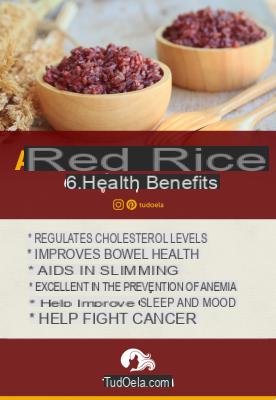
- Characteristics of red rice
- Nutritional values
- Properties and benefits
- White, brown or red rice?
Characteristics of red rice
You may have heard of brown rice, white rice, and even black rice, which are quite popular for their health effects, but are you familiar with red rice and its benefits?
Red rice is a variety of rice typical of tropical areas and South Africa, including Madagascar. Just like brown rice and white rice, red rice also has some incredible benefits for our body.
Precisely due to the presence of a component called anthocyanin, this rice it is usually eaten partially unpeeled. Its red color derives from this component and has a much higher nutritional value than other varieties of rice.
Nutritional values per 100 g:
- Calorie 405 Kcal;
- Protein 7g;
- Lipidi tot 4,9 g;
- Carbohydrates 86,7 g;
- Iron 5,5 mg;
- Potassium 256 mg.
Properties and benefits of red rice
Red rice helps control diabetes helping to regulate the insulin level. The low glycemic index of red rice helps to control the sugar level and is very suitable for diabetic patients.
Contains antioxidants to counteract free radicals, it is an excellent source of iron or manganese. Manganese is an antioxidant that can protect the body from free radicals that are physiologically formed inside the cell.
Additionally, red rice is rich in zinc, a mineral that can help accelerate wound healing and keep the body's defense mechanisms elevated.
It contains Vitamin B6: consuming a single portion of red rice can satisfy 23% of the daily requirement of vitamin B6. This particular vitamin is needed to help balance the development of serotonin, red blood cells while also aiding the formation of DNA in cells.
It can help to counteract the increase in triglycerides and LDL cholesterol: in 1970, scientific studies on humans reported the effect of red rice on the reduction of blood levels of total cholesterol. The active component of red rice is the monacolina K, a statin analog.
Despite this, it is still necessary to consult a health professional (Doctor, Nutritionist Biologist, Dietitian) to evaluate the real need to take red rice in the form of a supplement to counteract any rise in lipid parameters.
White, brown or red rice?
Brown rice and red rice are quite similar in nutritional terms. Both are great sources of fibers, vitamins of the group B, calcium, zinc and iron, manganese, selenium, magnesium and other nutrients.
One thing that sets the red variety apart from its brown counterpart is that the first is enriched with antioxidants which can help fight harmful free radicals in our body.
Il white rice instead it is mainly made up of starch. Due to the processing it undergoes, it lacks some essential nutrients such as thiamine, also known as vitamin B1 and other B vitamins.
Consuming unenriched white rice can lead to a condition called beriberi, which occurs due to thiamine deficiency. White rice is also, many times, treated with additives that can - in some cases - damage the human body and trigger metabolic disorders such as diabetes, obesity.


























